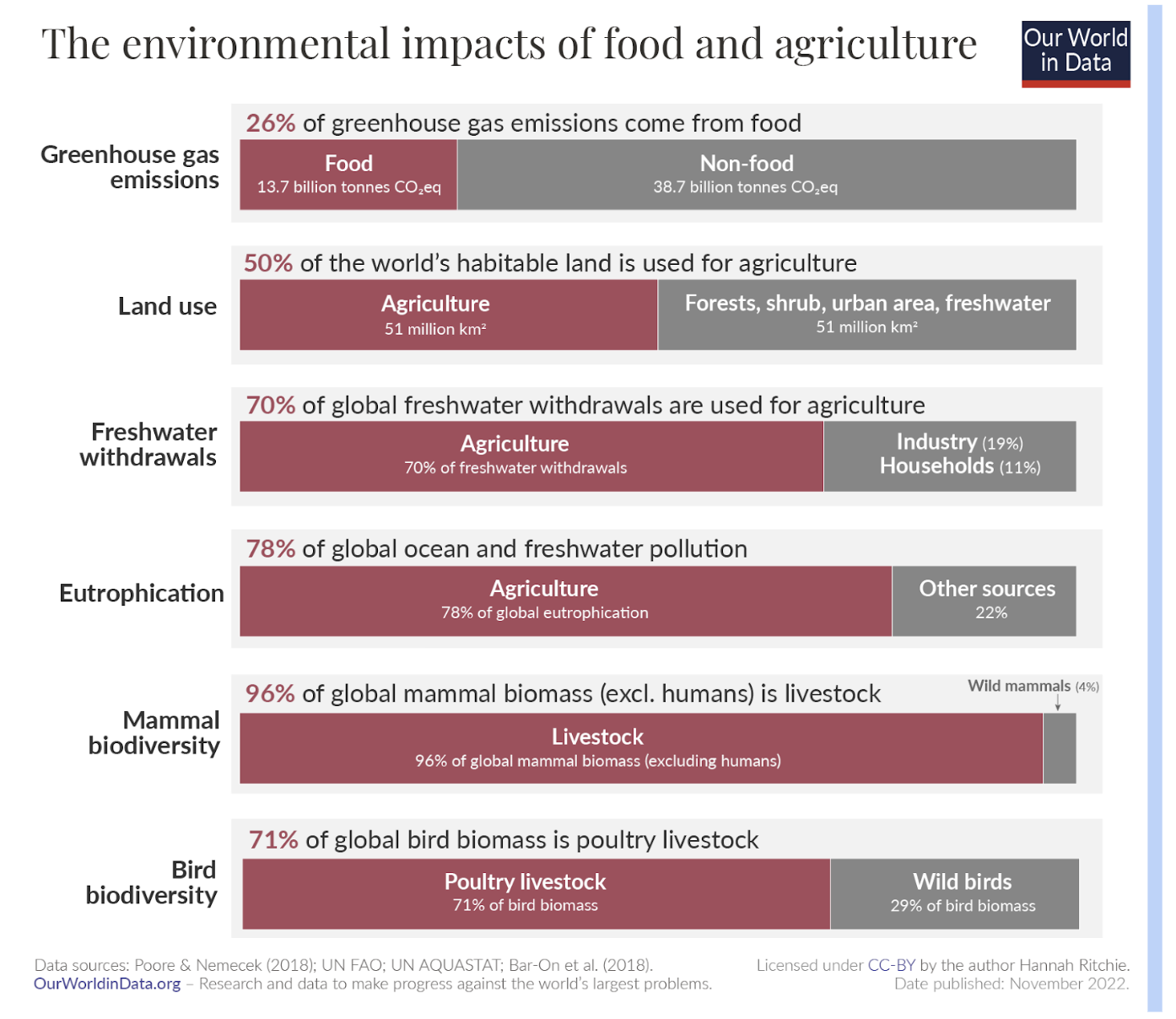About Regenerative Agriculture
DEFINING REGENERATIVE AGRICULTURE, ITS BENEFITS & CHALLENGES & WHAT IT LOOKS LIKE IN PRACTICE
Global food and agriculture systems are key drivers of the current climate crisis, particularly in terms of greenhouse gas emissions, soil degradation, and biodiversity loss.
Our global food and agriculture systems are major drivers of our environmental crises, particularly in terms of greenhouse gas emissions, soil degradation, chemical use, and biodiversity loss. As the graph below from Our World In Data illustrates, 26% of global emissions result from food and agriculture, and 50% of our habitable land is used for farming. According to the Food and Agriculture Organization of the United Nations, a third of the Earth’s topsoil has been degraded and over 90% could become degraded by 2050, and intensive farming practices – such as deforestation, high levels of agrichemical use, and overgrazing – are significant contributors to this degradation.
Our current farming practices are a reflection of our linear economy, where resources flow in one direction: extracted from the earth, sold to consumers, then disposed of. In order for farming to become sustainable, it must move towards a circular model, where waste is eliminated and resources are cycled back into the earth. Regenerative agriculture has gained a lot of attention and endorsement in recent years as a means of moving towards a circular economy, however, it has also suffered from a lack of a standardised definition and has become somewhat of a buzz word, like ‘sustainability’. This page seeks to clarify what exactly regenerative agriculture is and how we define it, its benefits and challenges, and what it can look like in practice.

What is Regenerative Agriculture?
As already acknowledged, regenerative agriculture has suffered from lack of a clear and shared definition. To add to the complexity, there are those who use the term “regenerative” synonymously with “organic”, as well as multiple different organic certifications available in many countries with differing requirements. Through our research and work with clients, Go Well has come to define regenerative agriculture as not a specific practice, but rather a philosophy and approach to land management. It is a holistic and dynamic approach, which varies from farm to farm and grower to grower, due to changes in local environment and ecology, with the overall intention of restoring and conserving land and ecosystems, as well the health and well being of farmers their animals, and their communities.
Regenerative Agriculture seeks to regenerate the health of the land, which shifts farming from a linear process to a circular one. Or as Greenpeace puts its, at its core Regenerative Agriculture is “farming with the environment, not against it”.
It seems that there are the following agreed outcomes from farming regeneratively:
- The sequestration of carbon into the soil and improved soil health
- The improvement of biodiversity on a farm and the local environment (e.g. cleaner air and water, and increased populations of native species)
- Improved health and wellbeing of farm workers and their communities
- Reduced (ideally elimated) use of synthetic chemicals and fertilisers, and if used only in very targeted ways
- Continual improvement
There also seems to be the below agreed practices to farm regeneratively:
- No tilling (aka ploughing) of the soil
- A wide diversity of crops are grown and these crops are rotated
- Animals and plants are part of the farm system
- No bare soil/the use of cover crops
Resources
For those wanting to explore the definition of Regenerative Agriculture more in depth, we recommend the following resources:
- The Natural Resource Defense Council
- Rodale Institute
- Our Land and Water NZ
- Patagonia (See the fantastic short films below)
- Pure Advantage
- Danone
Or, for those of you who love a good explainer video, we love the below two short films by Patagonia:
The Debates
While some practices are widely agreed as falling under the regenerative agriculture bracket, some are more controversial:
Synthetic chemicals
In traditional agriculture, synthetic chemicals are used to keep weeds and pests from destroying crops (herbicides and pesticides), add more nutrients to the soil (fertiliser), and treat animals (antibiotics). There is a stong narrative that the use of synthetic chemicals is not regenerative, particularly from practitioners that equate “regenerative” with “organic”. However, some practitioners are more reluctant to say there’s a one size fits all approach to the issue, and that judicial use of synthetic inputs can support the ultimate goals of regenerative farming, such as antibiotics being used to improve livestock health and wellbeing. They also make the argument that there are occasions where the cost, time line, and practicalities of non-chemical solutions are prohibited e.g. restoring a piece of land that is inundated with mature pest species.
Genetically modified seeds/crops
Genetic modification (GM) is the act of manipulating an organism’s genes using technology. GM has been used in framing to create crops that are insect resistant and are tolerant to herbicides, helping farmers to control weeds without needing to till the soil. As an inherently unnatural process, there is a strong argument that GM is not regenerative. Again, however, there is a counter argument that GM can be used to support the desired outcomes of regenerative agriculture, through reducing the amount of inputs (water and chemicals) required to take care of crops and increase the amount of carbon sequestered into the soil, a consideration that takes on more importance as our climate continues to chang, and global population grows, and our available arable land decreases.
The Benefits of Regenerative Agriculture
Regenerative Agriculture yields benefits for the planet, businesses, and communities:
Environmental benefits
- Improved health and fertility of soil, which produces healthier and more plentiful crops.
- Reduced soil erosion.
- An increase in biodiversity in the soil, which leads to an increase in biodiversity on land and in the water.
- Improved water quality and quantity, with reductions in water pollution and increased water-holding capacity in the soil.
- Reduced emissions and increased carbon sequestration, through the reduction of agrichemial use and soil disruption (tilling), and by maintaining covered soils.
- Increased crop resilience.
Business benefits
- Increased revenue from greater crop and animal quality and yield, as a result of healthier soil.
- Decreased costs from a reduction in chemical fertilisers and antibiotics.
- Greater financial security from diversification of revenue streams and increased farm resilience.
- Rural economic development with increased local employment and healthier food options.
- Long-term sustainability of soil and crop and animal production.
Community benefits
- Improved health of practitioners and downstream communities from reduced use of harmful chemicals.
- Increased community resilience, with farms better able to withstand severe weather.
- Growth of community networks where practitioners can exchange information, share learnings, and support one another.
- Increased sense of happiness and wellbeing. Interviewees of the Natural Resources Defense Council (NRDC) reported greater feelings of happiness and enjoyment in their transition from industrial to regenerative agriculture, one reason being that they “have more free time from working with nature instead of against her.”
The Challenges of Regenerative Agriculture
The benefits of Regenerative Agriculture are apparent, but the approach does have its challenges:
- Requires specialised knowledge: in order to transition to a regenerative model, farmers need to acquire specialised knowledge and skills, particularly around soil management.
- Time: transitioning to a new agricultural system takes time and establishing the methods of Regenerative Agriculture can takes years – reaping the benefits won’t happen overnight.
- Cost: upfront investment in new infrastructure will be required and profit margins will likely be affected in the transition. Many farmers currently find themselves in a financial bind with banks and other loan agencies who lack the Regenerative Agriculture knowledge and demand that repayments are met at regular intervals. Government subsidies for Regenerative Agriculture are still relatively uncommon.
- Additional work: the transition to Regenerative Agriculture will be labour-intensive in the initial stages, and moving away from tilling and chemicals will likely mean more unwelcome plants (weeds) to deal with.
- Rigorous certification processes: for those wanting to pursue certifications (such as BioGro or Regenerative Organic Alliance), the process is challenging and represents additional costs.
Regenerative Agriculture in Practice
Interest in and application of regenerative agriculture has been building momentum globally, both within business and government. Multinational giants like PepsiCo, Nestlé, Danone, and McCain have all committed to transitioning to regenerative agriculture on a large scale. In 2022, the US made a historic $20 billion investment in agricultural conservation programs, providing huge down payments to bolster regenerative agriculture. Grassroots organisations are springing up all around the globe to further support the transition away from traditional farming.
Interest in regenerative agriculture has also been building in New Zealand. In 2022, the government announced an investment of $26.1 million into New Zealand’s largest ever study on sustainable farming, and in February 2023, the Minister of Agriculture announced that $2 million would be invested into a research project on regenerative farming practices of arable and vegetable crops in Hawke’s Bay.
At Go Well, we’re big proponents of regenerative agriculture and we’re thrilled to have worked on a number of related projects with our clients. We supported Maggie Marilyn with developing their Regenerative Agriculture Report, in order to define regenerative agriculture for their business and understand the farming practices of their existing growers. We worked with Otis Oat Milk on developing their 1% Fund Policy, which donates 1% of their annual revenue to fund projects and initiatives that make oats a viable alternative for New Zealand farmers, with a focus on sustainable and restorative farming. We’ve also worked with a number of other fashion and food/beverage businesses to develop sustainability strategies that include a focus on working with growers following and/or transitioning to regenerative agricultural practices. If you’re interested in what your business’ approach to regenerative agriculture could look like then get in touch, we’d love to hear from you.
Learn more about our world with our useful resources.
